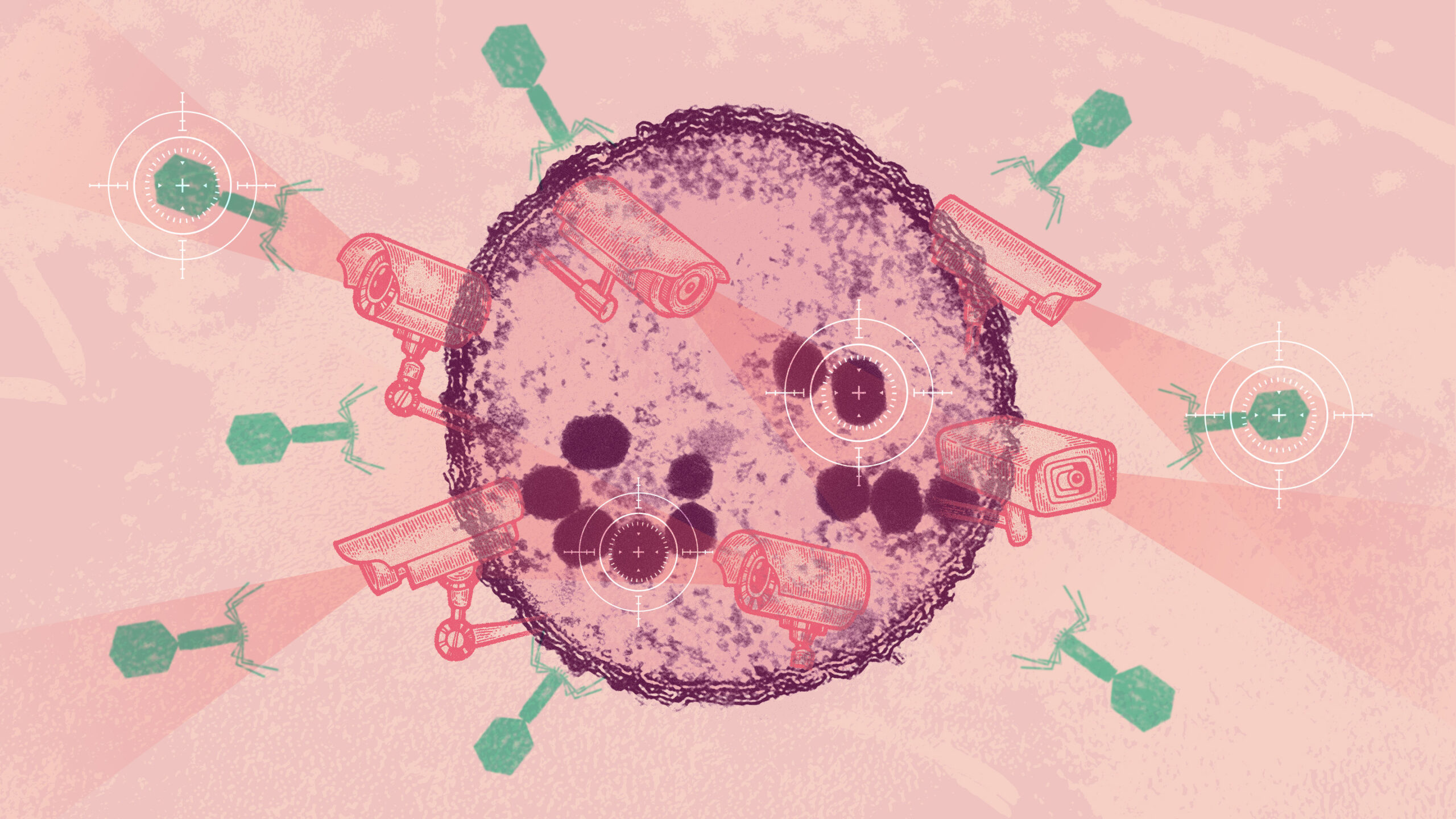Bacteria’s Immune Sensors Reveal a Novel Way to Detect Viruses

Kristina Armitage/Quanta Magazine;
Lee D. Simon/Science Source
Introduction
“All of the life forms on Earth have the same problem,” said Jonathan Kagan, an immunology researcher at Boston Children’s Hospital. “And that is dealing with infection.” Just as we worry about bacterial infections, bacteria are on the watch for the viruses called phages that infect them, and — like every organism across every kingdom of life — they have evolved an arsenal of molecular tools to fight infections.
Large, complex creatures like humans can splurge on immense immune systems of specialized cells that detect or destroy invaders. Simpler organisms such as plants and bacteria often need to rely instead on suites of multitasking proteins that, like Swiss Army knives, are equipped for both jobs. Because defense is such a universal concern, it’s not surprising that many of these defensive systems have been preserved through evolution and shared among diverse organisms, including humans.
But a new study published this month in Science discovered that a family of proteins in bacteria and archaea, the simple prokaryotic cells that are the oldest form of life, detect viruses in a way never seen before.
Fits Like a Glove
Because of advances in gene sequencing and bioinformatic techniques, many of the antiviral defenses that bacteria use have started to come into view only within the last 50 years. But interest in them has ballooned in the past decade due to the powerful gene-editing tool that harnesses the bacterial CRISPR-Cas9 system. The tool’s success has prompted researchers to give more focus to how bacterial molecules recognize viruses and eliminate them.
Some of these antiviral defenses, such as CRISPR-Cas9, recognize specific sequences in the DNA that a phage injects into its host. Others don’t directly sense fragments of the virus but respond to evidence of the harm the virus causes, such as damaged DNA or malfunctioning cellular processes — the molecular equivalents of the broken glass at the scene of a break-in.
But the bacterial immune sensors called Avs proteins don’t do either, as researchers led by Feng Zhang of the Massachusetts Institute of Technology and Eugene Koonin of the National Center for Biotechnology Information have now discovered. Avs proteins can directly detect viral proteins manufactured by the cell’s hijacked machinery.
Protein surveillance is a risky strategy for microbes: Even a few mutations can render a protein’s amino acid sequence unrecognizable, enabling a pathogen to escape detection. The adaptive immune systems in humans and other vertebrates can chase viral proteins because they can deploy billions of specialized cells to conduct the search — an option not open to individual bacteria.
Yet Zhang’s group found that Avs proteins aren’t bothered by little changes in amino acid sequences — or by big ones, for that matter. “We tested 24 different phages, spanning nine phage families,” said Alex Gao, a biochemist at Stanford University and the lead author on the paper, “and found that there was almost this across-the-board activation” of Avs.
The targeted proteins in the different viral families had almost completely different amino acid sequences, but they all performed the same job: spooling up strands of viral DNA and packing them into newly formed virus particles. Consequently, they all retained the same functional shape.
Avs proteins take advantage of this molecular resemblance, the team realized. The proteins were “recognizing three-dimensional folds and shapes, rather than sequences,” Gao explained. An Avs protein “basically wraps like a glove around a hand.” This type of 3D structural recognition “doesn’t have a whole lot of precedent, as far as we know, in molecular biology,” he added.
The only way for these viral proteins to escape Avs detection would be to mutate into an unrecognizable shape. But “to change the shape without destabilizing the protein or otherwise compromising its function in the phage is not trivial,” said Koonin.
The versatile, wraparound recognition skills of the Avs proteins aren’t limited to spotting viruses that infect bacteria. Koonin recalled asking Gao as a joke whether the Avs proteins could detect animal herpesviruses — very distant relatives of the phages tested in the paper. To his surprise, Gao responded, “‘Yes, we have already done that! They do.” Avs proteins recognized the DNA-packing proteins in human herpesviruses, although the recognition was weaker than for the bacterial phages.
“It’s the first time that I know of that an invader-recognizing element can identify viruses that infect such distant organisms,” said Rotem Sorek, a microbial geneticist at the Weizmann Institute of Science who was not involved in the study.
When Avs proteins detect viral proteins, they can strike out at the virus in a variety of ways — at least some of which end in bacterial self-destruction. Cellular suicide may seem unintuitive as a defense, but bacteria often live in colonies with strong genetic similarity. By destroying themselves, infected cells can protect neighbors that are essentially their twins, which “makes perfect sense” as an evolutionary strategy, Koonin said.
Besides, by the time viral proteins become apparent to the Avs defenses in a bacterium, the virus is already assembling copies of itself and will soon burst out of the infected cell. At that point, said Sorek, “there’s no escape from death by the phage anyway.”
Tiny Teachers
In their studies of other immune defenses in bacteria and archaea, researchers have uncovered striking parallels to those in the more complex eukaryotic cells of humans and other organisms. Some of these genetic similarities in form and function are close enough to suggest that we eukaryotes directly inherited some of our defenses from our prokaryotic ancestors.
Whether we inherited anything of the Avs proteins remains to be seen. While a smattering of human innate immune sensors recognize specific pathogen proteins, no one has yet found anything like protein-shape recognition at work in our innate immune sensors. Avs proteins have some intriguing structural similarities to certain eukaryotic defensive molecules, but the resemblance might be a product of convergent evolution and the power of pattern recognition as a defensive strategy. “It’s possible that nature just really likes making these [immune sensors] because it works really well,” said Gao.
Given how well protein-shape recognition works for bacteria and archaea, we might expect something like Avs proteins to turn up eventually in eukaryotes. Kagan thinks that, if nothing else, this discovery could spark interest in studying proteins as the targets of innate immune responses.
Bacteria “have not stopped teaching us,” Kagan said. “They taught us about DNA replication, they taught us about DNA repair, they taught us about cell division, and now they can teach us about immunity.”



